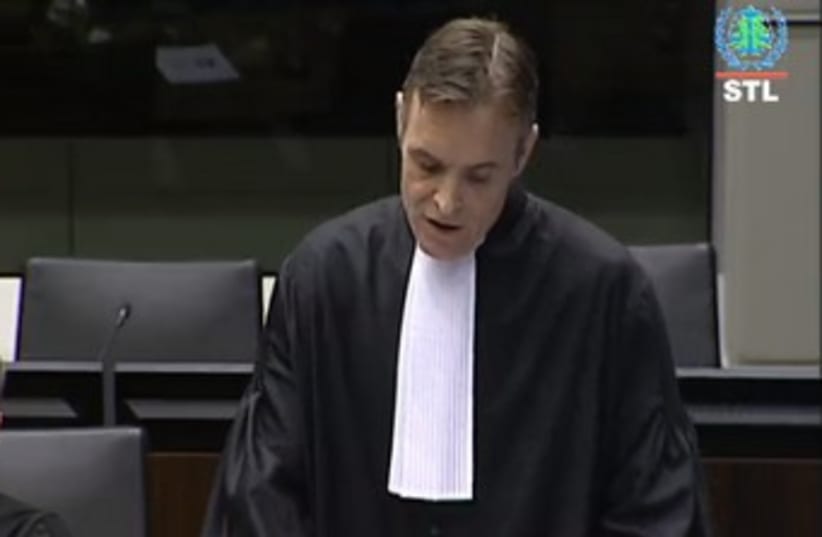The Special Tribunal for Lebanon opened the trial in absentia on Thursday against four Hezbollah defendants alleged to have assassinated former Lebanese prime minister Rafik Hariri and killed 21 others on February 14, 2005.
The case has riled, divided and inflamed already hot disputes between Lebanon’s Sunni and Shi’ite population, with Sunnis demanding justice and Hezbollah claiming the case was pushed forward by Western countries trying to reduce and besmirch its name.
Thursday’s hearing garnered massive international interest, was broadcast in English, Arabic and French and involved a full courtroom of a couple of dozen lawyers, all of who made initial introductions.So far, the trial involves four previously announced defendants – senior Hezbollah figure Mustafa Amine Badreddine (relative of the killed notorious Hezbollah commander Imad Mughniyeh), Salim Ayyash, Hussein Hassab Oneissi and Sassad Hassan Sabra.However, on Tuesday the Special Tribunal heard its prosecutor’s request to add a fifth, separately indicted defendant to the trial, Hassan Habib Merhi, leaving the possibility open that he may be added soon.Despite years of attempts to locate the defendants, including visits to their known residences, meetings with village elders from their home villages and meetings with Hezbollah representatives, none of these men has been found.In some cases, officers of the court, trying to serve the indictment to defendants, were prevented from doing so by Hezbollah security or only allowed to do so at a later date – when no one was home.Ultimately, the court found that advertising and media stories had reached nearly the entire adult population of Lebanon, and considered all defendants on notice of the case and in willful violation of the obligation to appear in court.The court is a tribunal of international character established on March 1, 2009, with headquarters on the outskirts of The Hague as well as an office in Beirut.The primary reason it was established was to hold trials for persons accused of carrying out the attack in the Hariri assassination.The trial opened with a statement by the tribunal’s presiding judge David Re, decked out in the black, red and white robes like each of the five judges on the panel.He said he had been told that the trial would involve hundreds of witnesses and thousands of exhibits, and briefly revealed the background of the case.Next, the prosecutor started his opening statement – to contextualize the case – which, along with statements by the legal representatives of the victims participating in the proceedings and the defense, were expected to take a few days.Showing pictures of the horrid scene of the attack, the prosecutor said that “the people of Lebanon have the right to this trial” to “seek the truth, to reveal the identity of the killers who tried to conceal their identity.”The prosecutor continued that “the truth leaves its traces,” including “considerable communications data” that gives a “blueprint of how the crime was committed” and regarding “who conspired to assassinate Hariri.”He added that the defendants “not only not did not care about” killing many of their fellow citizens, “but that they intended to do so,” since they “used far more explosives than needed to kill the target [Hariri].”The prosecutor then elaborated on the complex plan of the defendants to manufacture a video of the attack in order to throw any investigation off their trail.Next, the prosecutor showed eerie video camera pictures of the vehicle used to perpetrate the suicide bombing as it got closer and closer to Hariri.He detailed how the vehicle temporarily pulled off course to find a waiting spot, when Hariri unsuspectingly left a meeting to talk to bystanders on the street, delaying his expected departure time from the meeting as well as the time that the suicide bomber intended to intercept him in-transit.The prosecutor said that there was proof that the attack was a suicide bombing, from the finding of mostly disintegrated DNA pieces of an unidentified person consistent with a suicide bombing, as well as noting that three of the cars that were bombed were equipped with devices to disrupt remote bombing attempts.Video footage of the attack displayed by the prosecution showed that massive carnage and smoke from the bombing rising as much as a couple of hundred feet in the air and which could be seen from extreme far distances.This procedure is noteworthy, both in the participation of a victims’ representative (not a regular occurrence in criminal cases that usually only include prosecution and defense), and in that the defense counsel was appointed by the court – since no defendants ever accepted the court’s jurisdiction.